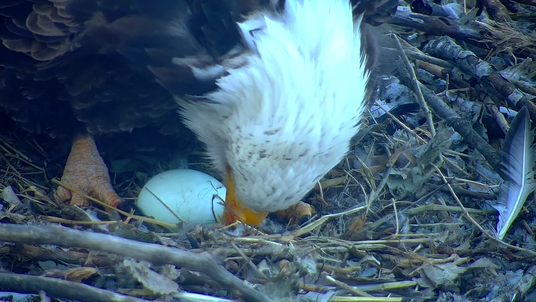|
February 14, 2022
 February 14, 2022
We are so egg-cited to share that we have our first egg on Nongame Wildlife EagleCam! At about 5:16 on Saturday, February 12, our female laid her first egg of 2022.
Nearing sunset is when eagles tend to lay their eggs. Late Saturday afternoon, the female flew into the nest, but quickly left. Sigh. Our eggs-pectations dashed. No egg today. But wait! She returned a few minutes later and decided it was time! She settled in and eventually began labored breathing and laid her first egg of the year. She then got up, gave it a first roll, and settled back into the warmth of the grass-lined bole the parents have prepared to keep it warm in the frigid Minnesota weather. Since egg arrival, she and her mate have been trading off egg-sitting to give each other breaks for wing stretches and hopefully, food. This will continue for at least the next 40 days.
Incubation has begun. Incubation begins after the first egg is laid, meaning that in a nest with more than one egg there will be an oldest sibling, a youngest sibling and occasionally a middle sibling. Both the male and the female incubate the eggs and both have brood patches, though the female tends to do the bulk of the incubating and has a much more developed brood patch. The brood patch is an area of bare skin on the bird’s breast that is formed when the bird removes its own feathers. By removing the feathers the parent bird allows his/her body heat to better reach the eggs and keep them at the proper temperature. the parents will sit on the nest almost continuously.
Incubation lasts from 34-36 days and eaglets hatch from the eggs without any help from
the parents. Pipping, as the hatching process is called, can take an entire day. The oldest egg hatches first and its younger sibling follows 1-4 days later.
Tune in to watch all of the egg-citement as the next eggs arrive! This beautiful bald eagle pair delicately tending to their eggs and to each other is truly one of nature's greatest wonders. We are fortunate to have a front row, up-close and personal seat to our amazing national bird!
We want to thank you for your continued support of the Nongame Wildlife Program. We rely on your contributions and we just couldn't do our important work without your support. YOU make our program and we thank you!
Happy Valentine's Day!
|